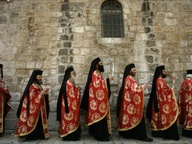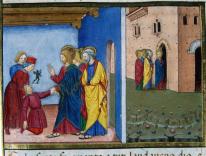One of the earliest Christian controversies involved the proper date for Easter. It is usually called the "Quartodeciman" controversy, since it was about whether or not Easter ought to be celebrated on "14" of the month Nisan. In modern times, the split was not about the Jewish lunar calendar, but about two different Christian calendars: the Gregorian (West) and the Julian (East). This division is the reason why almost all Orthodox churches celebrate Easter on a different date than those in the Roman Catholic Church.  Last week, Giorgio Bernardelli of the "Vatican Insider" blog of La Stampa reported that change is coming for many Catholics in the Holy Land. In 2013, Catholics in parts of the Holy Land (excepting Jerusalem and Bethlehem) will celebrate Lent and Easter according to the Julian calendar. Bishops of the Latin rite have been asking for this for a number of years, as was reported by Catholic News Service two years ago at the synod about the Middle East. The idea is that, at the central moment of the liturgical year, the unity of Christians might be expressed. An unofficial translation of the Italian has been provided by Murray Watson on a Jewish-Christian relations listserv, and I post it here:
Last week, Giorgio Bernardelli of the "Vatican Insider" blog of La Stampa reported that change is coming for many Catholics in the Holy Land. In 2013, Catholics in parts of the Holy Land (excepting Jerusalem and Bethlehem) will celebrate Lent and Easter according to the Julian calendar. Bishops of the Latin rite have been asking for this for a number of years, as was reported by Catholic News Service two years ago at the synod about the Middle East. The idea is that, at the central moment of the liturgical year, the unity of Christians might be expressed. An unofficial translation of the Italian has been provided by Murray Watson on a Jewish-Christian relations listserv, and I post it here:
In 2013, the Catholic parishes of the Holy Land will celebrate Easter together with the faithful of the Orthodox churches on May 5, and not on March 31, as the rest of the world's Catholics willGiorgio Bernardelli, RomaOctober 17, 2012 This is an important decision, as a major step in the ecumenical journey. The Latin Patriarchate of Jerusalem has made this decision, by means of a decree published today. The idea had already been anticipated by Vatican Insider a few months ago, and represents a significant ecumenical precedent. In practice, the Julian calendar will be adopted instead of the Gregorian calendar, as regards Lent, Easter and Pentecost, responding to a request which had also surfaced at the Synod for the Middle East, which was celebrated in 2010.The idea is that, at least in the most central moment of the liturgical year, the unity among Christians might be able to be expressed, and might thus help to overcome the paradox of a division which, until now, has even had an impact on the level of the home, since weddings between the faithful of the Latin and Eastern rites are quite frequent in the Holy Land.This provision has been adopted on an experimental basis for the year 2013, aware that in 2014, the date of Easter on both calendars will coincide (April 20), and so, for the next year, the issue will not arise. In the meantime, the Assembly of Catholic Ordinaries of the Holy Land will draft a definitive decree, which it will present to the Holy Land for canonical approval; it is the hope of local bishops that, by 2015, the Vatican will have "given a green light," and that this decision could thus become definitive [i.e., permanent].Another important point concerning the places in which the experiment of a common Easter will be applied: it will be in the parishes of Israel, of the Palestinian Territories, Jordan and Cyprus, which fall under the jurisdiction of the Latin Patriarchate. With, however, two important exceptions: Jerusalem and Bethlehem where, at least for 2013, the Gregorian calendar will continue to be followed (and where Easter will, therefore, be celebrated on March 31).The reason for this restriction lies in the rules of the "Status Quo," the old Ottoman-era edict which strictly regulates the schedule of liturgies and relations between the Christian denominations within the Christian holy places, which are shared by various denominations. Changing those rules in Jerusalem and Bethlehem appears, for the moment, to be only a dream. So, for pilgrims who come to the Holy Land, little should really change, at least in 2013.This remains, however, a major and important sign: the Holy Land is one of the places where the divisions between Christians is most clearly visible. Sometimes, people have found themselves in the midst of scuffles in the basilicas, between religious of the various Christian denominations. This initiative (which was launched by the Latin Patriarchate of Jerusalem) thus moves in the opposite direction, and has been undertaken as a response to a request which came primarily from the faithful themselves.It is, however, worth remembering that, even beyond the particular context of the Holy Land, Benedict XVI himself has on several occasions expressed his hope that Catholics and Orthodox would soon be able to arrive at an agreement for the celebration of Easter on the same date throughout the world. Jerusalem, therefore, is beginning to open up the path, and hopes that it can, in turn, shed light on the ecumenical journey.

